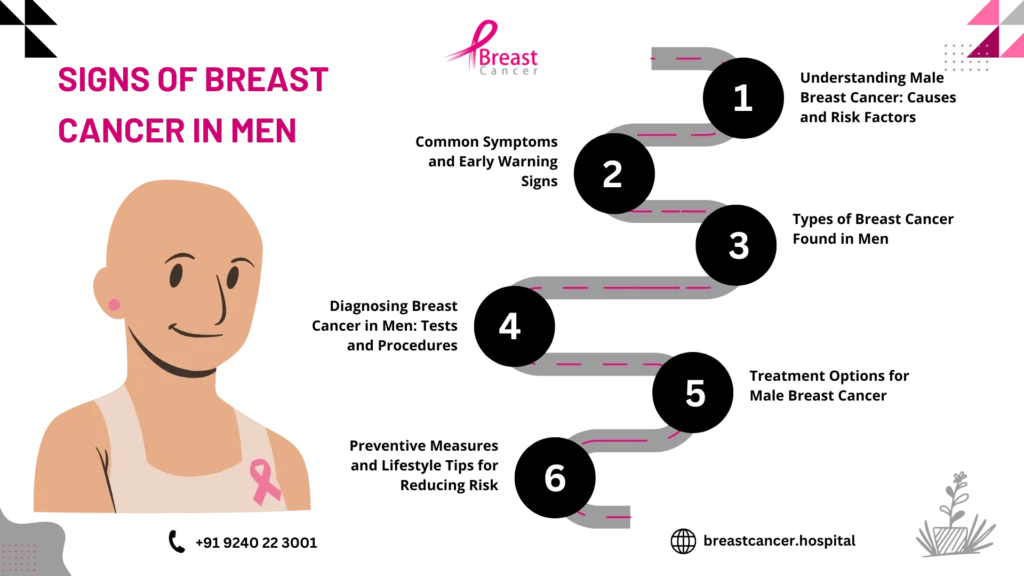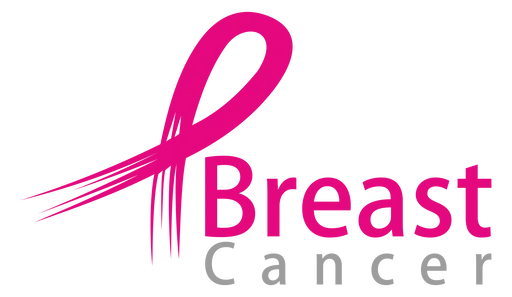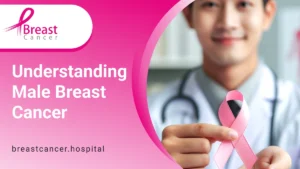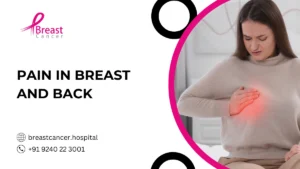Breast cancer is often associated with women, but men can also be affected. Recognizing the “signs of breast cancer in men” is essential for early diagnosis and treatment, which can significantly improve outcomes. In this post, we’ll cover key indicators of breast cancer in men, delve into the causes and symptoms, and discuss diagnosis and the role of pain in identifying the disease. By raising awareness and understanding the symptoms, men can take proactive steps toward early detection and treatment.
Male Breast Cancer
Is male breast cancer painful? In some cases, yes, but not always. Male breast cancer is rare, accounting for less than 1% of all breast cancer cases. Common symptoms include:
- A painless lump or thickening in the breast tissue.
- Changes in the skin over the breast, such as dimpling, redness, or scaling.
- Nipple discharge, which may be bloody.
- Inverted nipple or changes in its shape.
- Swelling or enlargement of the breast.
If you notice any of these symptoms, consult a healthcare provider for the diagnosis of breast cancer in men.

Types of Male Breast Cancer
There are several types of breast cancer that men can develop, each requiring specific treatments. The main types include:
- Invasive Ductal Carcinoma (IDC): The most common type, starting in the milk ducts and spreading to surrounding tissues.
- Invasive Lobular Carcinoma (ILC): Rare in men, as they have fewer lobules in the breast.
- Ductal Carcinoma In Situ (DCIS): Non-invasive cancer confined to the ducts.
- Paget’s Disease of the Nipple: A rare type that starts in the ducts and affects the nipple and areola.
Understanding the type is critical for determining the best Male Breast Cancer Treatment plan.
What are the Signs of Breast Cancer in Men?
The signs of breast cancer in men are similar to those in women, although they can be less noticeable due to smaller breast tissue. “What are the symptoms of male breast cancer?” you might ask. Common signs include a lump in the breast, changes in breast or nipple appearance, and skin changes around the breast area. Knowing these signs is crucial, as breast cancer in men often goes undetected until it reaches an advanced stage.
Recognizing Early Warning Signs
- Lumps or Thickening: A hard lump or thickening in the breast tissue, typically painless, is one of the earliest and most common signs of breast cancer in men.
- Changes in Breast Shape or Size: Swelling, puckering, or dimpling of the breast skin can be indicators of breast cancer.
- Nipple Changes: Changes in the nipple, such as inversion or discharge, are signs that warrant medical attention.
- Skin Irritation or Redness: Redness, scaling, or peeling of the skin around the nipple or breast area can also be an early symptom.
Recognizing these symptoms and taking prompt action by consulting a healthcare professional can make a significant difference in treatment outcomes.
Treatment for Breast Cancer in Men
Treatment options vary based on the stage and type of cancer. Common treatments include:
Surgery:
- Mastectomy: Removal of the entire breast tissue.
- Lymph Node Surgery: To check for cancer spread.
Radiation Therapy: Often used after surgery to eliminate remaining cancer cells.
Chemotherapy: Administered to target and kill cancer cells throughout the body.
Hormone Therapy: Effective for hormone receptor-positive cancers, blocking estrogen’s effects.
Targeted Therapy: Focuses on specific proteins or genes that contribute to cancer growth
If you’re wondering, is male breast cancer treatment painful, treatments can address both symptoms and the underlying condition. Consult with specialists for tailored care and improved outcomes.
Is Male Breast Cancer Painful?
One of the common questions is, “Is male breast cancer painful?” While breast cancer in men is often painless, some individuals may experience discomfort or tenderness in the breast area. Pain isn’t a primary symptom of male breast cancer but should not be ignored if accompanied by other warning signs.
When Pain May Occur
- Advanced Stages: In advanced stages of male breast cancer, pain may become more common as cancer spreads to surrounding tissues.
- Skin Changes: Pain may arise when there are skin changes, such as ulceration or open sores, due to cancer.
- Metastasis: If the cancer spreads to the bones or other organs, it can lead to more pronounced pain in areas beyond the breast.
While pain alone is not a definitive sign of breast cancer, men experiencing persistent breast discomfort along with other symptoms should seek medical evaluation. Early detection is key to improving survival rates.
Causes of Breast Cancer in Men
Understanding the “causes of breast cancer in men” is essential in recognizing risk factors and potentially lowering the chances of developing the disease. Male breast cancer is relatively rare, but certain factors increase the likelihood of developing it.
Key Risk Factors for Male Breast Cancer
- Genetics and Family History: Men with a family history of breast cancer, particularly if they have inherited BRCA1 or BRCA2 gene mutations, are at higher risk.
- Hormonal Imbalances: High levels of estrogen, often due to liver disease, obesity, or hormone therapy, can increase breast cancer risk.
- Age: The risk of male breast cancer increases with age, with most cases occurring in men over 60.
- Radiation Exposure: Prior radiation treatment to the chest area may raise the risk of breast cancer in men.
Though breast cancer in men is rare, being aware of these causes and discussing them with a healthcare provider can help assess risk levels and the need for regular screenings.
Diagnosis of Breast Cancer in Men
The “diagnosis of breast cancer in men” follows a process similar to that for women, involving physical exams, imaging, and biopsy. Early detection is vital, as male breast cancer is often diagnosed at later stages.
Steps to Diagnose Male Breast Cancer
- Physical Examination: A healthcare provider will examine the breast for lumps or other abnormalities.
- Imaging Tests: Mammograms, ultrasounds, and MRIs are used to visualize suspicious areas.
- Biopsy: A sample of breast tissue is taken and examined for cancer cells, confirming the presence and type of cancer.
- Genetic Testing: Men diagnosed with breast cancer may undergo genetic testing to determine if they carry BRCA mutations, which can influence treatment and future risk.
By seeking timely medical consultation, men can catch potential breast cancer in its earlier, more treatable stages.
What Are the Symptoms of Male Breast Cancer?
Returning to the question, “What are the symptoms of male breast cancer?” Let’s summarize the key symptoms that all men should watch for. The earlier these signs are recognized and addressed, the better the chances of effective treatment.
Common Symptoms of Male Breast Cancer
- Breast Lump or Thickening: Often painless but firm and fixed.
- Nipple Discharge: Any discharge from the nipple, especially if it is bloody or clear, should be evaluated.
- Nipple Retraction: The nipple turning inward is a possible sign of cancer.
- Swelling or Redness: Skin changes, including redness, scaling, or puckering, may indicate breast cancer.
- Pain or Discomfort: Although not common, pain in the breast can sometimes occur, particularly as the disease progresses.
Regular self-examinations and awareness of changes in the breast area are crucial for early detection. If any of these symptoms persist, consulting a medical professional is recommended.
Risk Factors
Understanding the risk factors is the first step in addressing what are the symptoms of male breast cancer and reducing the likelihood of developing it. Key risk factors include:
- Age: Most cases occur in men aged 60 and older.
- Genetics: Mutations in the BRCA1 or BRCA2 genes significantly increase the risk.
- Hormonal Imbalances: Elevated estrogen levels, often due to obesity, liver disease, or hormonal treatments, can contribute.
- Family History: A family history of breast cancer in men or women raises the risk.
- Radiation Exposure: Prior exposure to radiation in the chest area increases susceptibility.
Knowing these factors can help in taking preventive measures and recognizing the causes of breast cancer in men.
Prevention
While it may not be possible to completely prevent breast cancer, certain lifestyle adjustments can reduce the risk. These include:
- Maintaining a healthy weight to avoid hormonal imbalances.
- Limiting alcohol consumption.
- Regular exercise to improve overall health.
- Undergoing genetic testing if there’s a family history of breast cancer.
- Consulting a doctor for early screenings, especially if you are at higher risk.
Early detection is key. Awareness of the signs of breast cancer in men can lead to timely medical intervention.
Screening for Breast Cancer in Men
While there is no standard screening for male breast cancer like there is for women (e.g., mammograms), men at higher risk may need to undergo screenings or checkups. Early detection through self-examination and professional evaluation can help catch the disease early.
Screening tips for men:
- Regular self-exams: Men should check for lumps, changes in the skin, or other abnormalities in the chest area.
- Clinical examination: A doctor’s physical exam may identify changes in breast tissue.
- Genetic counseling: If a man has a family history of breast cancer or known genetic mutations, screening may be recommended.
Conclusion
Awareness of the “signs of breast cancer in men” is the first step toward early detection and treatment. Breast cancer in men, though rare, is a serious health issue that requires prompt attention. By recognizing symptoms, understanding causes, and knowing the diagnosis process, men can be proactive about their health and potentially catch cancer early. If you notice any changes in your breast area or have risk factors, consult a healthcare provider for an evaluation. Awareness saves lives, and early intervention is key to better outcomes.




